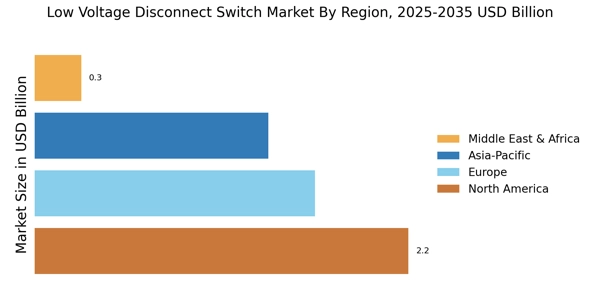Growth in Renewable Energy Integration
The integration of renewable energy sources is a significant driver for the Low Voltage Disconnect Switch Market. As the world shifts towards sustainable energy solutions, the need for efficient power management systems becomes paramount. Low voltage disconnect switches facilitate the seamless integration of solar panels, wind turbines, and other renewable sources into existing electrical grids. This trend is underscored by the fact that renewable energy capacity is projected to grow by 50% by 2025. The ability of these switches to manage variable power inputs and ensure grid stability is crucial, thereby enhancing their demand in the context of renewable energy adoption.
Regulatory Compliance and Safety Standards
Regulatory compliance and safety standards are increasingly influencing the Low Voltage Disconnect Switch Market. Governments and regulatory bodies are implementing stringent safety regulations to ensure the reliability and safety of electrical systems. For instance, the International Electrotechnical Commission (IEC) has established standards that mandate the use of disconnect switches in various applications. This regulatory landscape compels manufacturers to innovate and produce compliant products, thereby driving market growth. The need for safety in residential, commercial, and industrial applications further propels the demand for low voltage disconnect switches, as they are essential for protecting equipment and personnel from electrical hazards.
Rising Demand for Energy Management Solutions
The increasing emphasis on energy management solutions is a pivotal driver for the Low Voltage Disconnect Switch Market. As industries and consumers alike seek to optimize energy consumption, the demand for devices that can efficiently manage electrical loads has surged. This trend is reflected in the projected growth of the energy management market, which is expected to reach USD 100 billion by 2026. Low voltage disconnect switches play a crucial role in this ecosystem by providing reliable disconnection of power during peak loads, thereby preventing energy wastage. The integration of these switches into energy management systems enhances operational efficiency and reduces costs, making them indispensable in modern electrical infrastructure.
Technological Advancements in Electrical Components
Technological advancements in electrical components are reshaping the Low Voltage Disconnect Switch Market. Innovations such as smart disconnect switches, which offer remote monitoring and control capabilities, are gaining traction. These advancements not only improve operational efficiency but also enhance user experience by providing real-time data on energy consumption and system performance. The market for smart electrical components is expected to grow significantly, with estimates suggesting a compound annual growth rate (CAGR) of over 10% through 2027. As consumers and industries increasingly adopt smart technologies, the demand for advanced low voltage disconnect switches is likely to rise correspondingly.
Increasing Urbanization and Infrastructure Development
Increasing urbanization and infrastructure development are key drivers of the Low Voltage Disconnect Switch Market. As urban areas expand, the demand for reliable electrical infrastructure grows, necessitating the installation of efficient power management solutions. The construction of new residential, commercial, and industrial facilities requires robust electrical systems, where low voltage disconnect switches are essential for ensuring safety and reliability. According to recent data, urbanization rates are projected to reach 68% by 2050, leading to a surge in infrastructure projects. This trend is likely to bolster the demand for low voltage disconnect switches, as they are integral to modern electrical installations.


















Leave a Comment